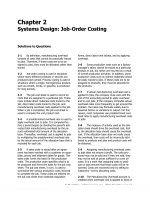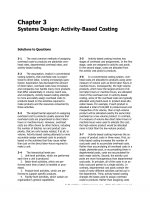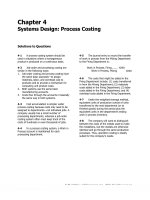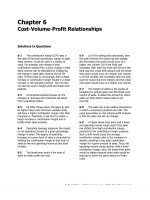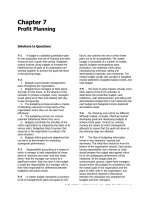Solution manual introduction managerial accounting 5e by garrison chapter 03
Bạn đang xem bản rút gọn của tài liệu. Xem và tải ngay bản đầy đủ của tài liệu tại đây (1.22 MB, 55 trang )
To download more slides, ebook, solutions and test bank, visit
Chapter 3
Systems Design: Activity-Based Costing
Solutions to Questions
3-1
The most common methods of assigning
overhead costs to products are plantwide overhead rates, departmental overhead rates, and
activity-based costing.
3-2
The assumption, implicit in conventional
costing systems, that overhead cost is proportional to direct labor, is being increasingly questioned. Automation has decreased the amount
of direct labor, overhead costs have increased,
and companies now handle many more products
that differ substantially in volume, batch size,
and complexity. Activity-based costing attempts
to more accurately assign overhead costs to
products based on the activities required to
make products and the resources consumed by
those activities.
3-3
The departmental approach to assigning
overhead cost to products usually assumes that
overhead costs are proportional to direct laborhours or machine-hours. However, overhead
costs are often driven by other factors, including
the number of batches run and product complexity, that are only loosely related, if at all, to
volume. Activity-based costing attempts to more
accurately assign overhead costs to products
based on the activities that they cause rather
than just on the direct labor-hours required to
make a unit.
3-4
The hierarchical levels are:
1. Unit-level activities, which are performed
each time a unit is produced.
2. Batch-level activities, which are performed each time a batch is handled or processed.
3. Product-level activities, which are performed to support specific products.
4. Facility-level activities, which sustain an
organization’s general capabilities.
3-5
Activity-based costing involves two
stages of overhead cost assignments. In the first
stage, costs are assigned to activity cost pools.
In the second stage, costs are allocated from
the activity cost pools to products.
3-6
In a conventional costing system, overhead costs are allocated to products using some
measure of volume such as direct labor-hours or
machine-hours. Consequently, the high-volume
products, which have the largest amount of direct labor-hours or machine-hours, are allocated
most of the overhead cost. In activity-based
costing, some of the overhead costs are typically
allocated using batch-level or product-level allocation bases. For example, if each product is
allocated a total of $10,000 in product-level cost
irrespective of its volume, then a high-volume
product will be allocated exactly the same total
overhead as a low-volume product. In contrast,
if a measure of volume like direct labor-hours or
machine-hours were used to allocate this cost,
the high-volume product would be allocated
more in total than the low-volume product.
3-7
Activity-based costing improves the accuracy of product costs in three ways. First, activity-based costing increases the number of
cost pools used to accumulate overhead costs.
Rather than accumulating all overhead costs in a
single, plantwide pool, or accumulating them in
departmental pools, costs are accumulated for
each major activity. Second, the activity cost
pools are more homogeneous than departmental
cost pools. In principle, all of the costs in an activity cost pool pertain to a single activity. In
contrast, departmental cost pools contain the
costs of many different activities carried out in
the department. Third, activity-based costing
changes the bases used to assign overhead
costs to products. Rather than assigning costs
© The McGraw-Hill Companies, Inc., 2010. All rights reserved.
Solutions Manual, Chapter 3
95
To download more slides, ebook, solutions and test bank, visit
on the basis of direct labor or some other measure of volume, costs are assigned on the basis
of the activities that presumably cause overhead
costs.
3-8
While the product costs computed using
activity-based costing are almost certainly more
accurate than those computed using more conventional costing methods, activity-based costing nevertheless rests on some questionable
assumptions about cost behavior. In particular,
activity-based costing assumes that costs are
proportional to activity. In reality, costs appear
to increase less than in proportion to increases
in activity. This implies that activity-based product costs will be overstated for purposes of
making decisions. (The same criticism can be
leveled at conventional product costs.) Second,
the costs of implementing and maintaining an
activity-based costing system can be high and
its benefits may not justify this cost.
© The McGraw-Hill Companies, Inc., 2010. All rights reserved.
96
Introduction to Managerial Accounting, 5th edition
To download more slides, ebook, solutions and test bank, visit
Brief Exercise 3-1 (10 minutes)
a. Receive raw materials from suppliers: Batch-level
b. Manage parts inventories: Product-level
c. Do rough milling work on products: Unit-level
d. Interview and process new employees in the personnel department:
Facility-level
e. Design new products: Product-level
f. Perform periodic preventive maintenance on general-use equipment:
Facility-level
g. Use the general factory building: Facility-level
h. Issue purchase orders for a job: Batch-level
Some of these classifications are debatable and depend on the specific
circumstances found in particular companies.
© The McGraw-Hill Companies, Inc., 2010. All rights reserved.
Solutions Manual, Chapter 3
97
To download more slides, ebook, solutions and test bank, visit
Brief Exercise 3-2 (15 minutes)
1. The activity rates are computed as follows:
Activity Cost Pool
Labor related ....................
Machine related ................
Machine setups .................
Production orders ..............
Product testing..................
Packaging .........................
General factory .................
Total ................................
(a)
Estimated
Overhead
Cost
$
48,000
67,500
84,000
112,000
58,500
90,000
672,000
$1,132,000
(b)
Expected
Activity
20,000 DLHs
45,000 MHs
600 setups
400 orders
900 tests
6,000 packages
20,000 DLHs
(a) ÷ (b)
Activity
Rate
$2.40
$1.50
$140.00
$280.00
$65.00
$15.00
$33.60
per
per
per
per
per
per
per
DLH
MH
setup
order
test
package
DLH
2. The predetermined overhead rate based entirely on direct labor-hours would be computed as follows:
Total estimated overhead cost (a) ...........
Total expected direct labor-hours (b).......
Predetermined overhead rate (a) ÷ (b) ...
$1,132,000
20,000 DLHs
$56.60 per DLH
© The McGraw-Hill Companies, Inc., 2010. All rights reserved.
98
Introduction to Managerial Accounting, 5th Edition
To download more slides, ebook, solutions and test bank, visit
Brief Exercise 3-3 (30 minutes)
The overhead costs assigned to each product would be computed as follows:
Labor related, at $6.00 per direct labor-hour .......
Machine related, at $4.00 per machine-hour .......
Machine setups, at $50.00 per setup...................
Production orders, at $90.00 per order ...............
Shipments, at $14.00 per shipment ....................
General factory, at $9.00 per direct labor hour ....
Total overhead cost assigned (a) ........................
# of units produced
Overhead cost per unit
K425
Expected
Activity
Amount
80
100
1
1
1
80
$ 480
400
50
90
14
720
$1,754
200
$8.77
M67
Expected
Activity
Amount
500
1,500
4
4
10
500
$ 3,000
6,000
200
360
140
4,500
$14,200
2,000
$7.10
The product costs combine direct materials, direct labor, and overhead costs as follows:
Direct materials ...........................................
Direct labor .................................................
Manufacturing overhead (see above) ............
Unit product cost .........................................
K425
$13.00
5.60
8.77
$27.37
M67
$56.00
3.50
7.10
$66.60
© The McGraw-Hill Companies, Inc., 2010. All rights reserved.
Solutions Manual, Chapter 3
99
To download more slides, ebook, solutions and test bank, visit
Brief Exercise 3-4 (30 minutes)
1. Using the company's conventional costing system, the overhead costs applied to the products would
be computed as follows:
Number of units produced (a) ..........
Direct labor-hours per unit (b) ..........
Total direct labor-hours (a) × (b) .....
Product H
50,000
0.20
10,000
Total manufacturing overhead (a) ............
Total direct labor-hours (b) ......................
Predetermined overhead rate (a) ÷ (b) .....
Manufacturing overhead applied per unit
0.20 DLH per unit × $160.00 per DLH ...
Number of units produced ........................
Total manufacturing overhead applied ......
Product L
10,000
0.20
2,000
Total
12,000
$1,920,000
12,000 DLHs
$160.00 per DLH
Product H
Product L
$
32.00
50,000
$1,600,000
Total
$ 32.00
10,000
$320,000 $1,920,000
2. Using the proposed ABC system, overhead costs would be applied as follows:
Product H Product L
Total manufacturing overhead applied (a) ....... $960,000
Number of units produced (b) ............................ 50,000
Manufacturing overhead per unit (a) ÷ (b) .......... $19.20
Total
$960,000 $1,920,000
10,000
$96.00
© The McGraw-Hill Companies, Inc., 2010. All rights reserved.
100
Introduction to Managerial Accounting, 5th Edition
To download more slides, ebook, solutions and test bank, visit
Brief Exercise 3-4 (continued)
3. Under the company’s old method of allocating overhead costs, the highvolume product, Product H, was allocated most of the overhead cost.
This occurred simply because the high-volume product is responsible for
most of the direct labor-hours. When the overhead is split evenly
between the two products, $640,000 of overhead cost is shifted from
the high-volume product, Product H, to the low-volume product, Product
L. Consequently, the shift from direct labor-hours as an allocation base
to an even split of the overhead costs between the two products favors
the high-volume product, Product H, and penalizes the low-volume
product, Product L. Note that on a per unit basis, the impact is much
greater for the low-volume product, Product L, than for the high-volume
product, Product H. This is because the impact per unit of shifting the
$640,000 in overhead costs is much greater for the low-volume product
than for the high-volume product.
© The McGraw-Hill Companies, Inc., 2010. All rights reserved.
Solutions Manual, Chapter 3
101
To download more slides, ebook, solutions and test bank, visit
Brief Exercise 3-5 (45 minutes)
1. The journal entries are:
a. Raw Materials ........................
Accounts Payable ................
854,000
b. Work in Process .....................
Manufacturing Overhead ........
Raw Materials .....................
780,000
68,000
c. Work in Process .....................
Manufacturing Overhead ........
Wages Payable ....................
330,000
55,000
d. Manufacturing Overhead ........
Accumulated Depreciation ....
225,000
e. Manufacturing Overhead ........
Accounts Payable ................
194,000
854,000
848,000
385,000
225,000
194,000
f. Compute the amount of overhead applied.
Activity Cost Pool
Machine related ................
Purchase orders ................
Machine setups .................
General factory .................
Total ................................
Activity
Rate
$24
$85
$175
$16
Actual
Activity
3,800
700
400
22,000
Work in Process .....................
Manufacturing Overhead ......
572,700
g. Finished Goods ......................
Work in Process ..................
1,690,000
Overhead
Applied
$ 91,200
59,500
70,000
352,000
$572,700
572,700
1,690,000
© The McGraw-Hill Companies, Inc., 2010. All rights reserved.
102
Introduction to Managerial Accounting, 5th Edition
To download more slides, ebook, solutions and test bank, visit
Brief Exercise 3-5 (continued)
2.
Bal.
(a)
Bal.
Raw Materials
18,000 (b)
854,000
24,000
Bal.
(g)
Finished Goods
46,000
1,690,000
848,000
Bal.
(b)
(c)
(f)
Bal.
Work in Process
24,000 (g)
1,690,000
780,000
330,000
572,700
16,700
Accumulated Depreciation
(d)
225,000
Accounts Payable
(a)
854,000
(e)
194,000
Wages Payable
(c)
385,000
Manufacturing Overhead
(b)
68,000 (f)
572,700
(c)
55,000
(d)
225,000
(e)
194,000
Bal.
30,700
3. The overhead overapplied or underapplied can be computed as follows:
Actual overhead incurred ................ $542,000
Overhead applied ........................... 572,700
Overhead overapplied..................... $(30,700)
© The McGraw-Hill Companies, Inc., 2010. All rights reserved.
Solutions Manual, Chapter 3
103
To download more slides, ebook, solutions and test bank, visit
Exercise 3-6 (30 minutes)
1. Entry (a) is the amount of actual manufacturing overhead cost incurred
during the year. Debits to Manufacturing Overhead represent actual
overhead costs incurred and credits represent overhead applied to
products.
2. The activity rates would be computed as follows:
Activity Cost Pool
Labor related ...........
Purchase orders .......
Parts management ...
Board etching ..........
General factory ........
(a)
Estimated
Overhead
Cost
(b)
Expected
Activity
$280,000
$90,000
$120,000
$360,000
$400,000
40,000
1,500
400
2,000
80,000
(a) ÷ (b)
Activity
Rate
DLHs
$7 per DLH
orders
$60 per order
part types $300 per part type
boards
$180 per board
MHs
$5 per MH
3. Computation of the manufacturing overhead cost applied to production:
Activity Cost Pool
(a)
Activity
Rate
(b)
Actual
Activity
Labor related..........
$7 per DLH
41,000 DLHs
Purchase orders .....
$60 per order
1,300 orders
Parts management . $300 per part type
420 part types
Board etching ......... $180 per board
2,150 boards
General factory.......
$5 per MH
82,000 MHs
Total ......................
(a) × (b)
Applied
Overhead
$ 287,000
78,000
126,000
387,000
410,000
$1,288,000
4. The overhead overapplied or underapplied can be computed as follows:
Actual overhead incurred .......
Overhead applied ..................
Overhead underapplied .........
$1,302,000
1,288,000
$ 14,000
© The McGraw-Hill Companies, Inc., 2010. All rights reserved.
104
Introduction to Managerial Accounting, 5th Edition
To download more slides, ebook, solutions and test bank, visit
Exercise 3-7 (30 minutes)
The overhead applied to each product can be computed as follows:
Activity Cost Pool
Product A
(a)
(b)
Activity
Actual
Rate
Activity
(a) × (b)
Applied
Overhead
Labor related ..........
$7/DLH
8,000 DLHs
$ 56,000
Purchase orders ...... $60/order
100 orders
6,000
Parts management .. $300/part type
20 part types
6,000
Board etching ......... $180/board
0 boards
0
General factory .......
$5/MH
16,000 MHs
80,000
Total ......................
$148,000
Product B
Activity Cost Pool
(a)
Activity
Rate
(b)
Actual
Activity
(a) × (b)
Applied
Overhead
Labor related ..........
$7/DLH
12,000 DLHs
$ 84,000
Purchase orders ...... $60/order
300 orders
18,000
Parts management .. $300/part type
90 part types
27,000
Board etching ......... $180/board
1,500 boards
270,000
General factory .......
$5/MH
24,000 MHs
120,000
Total ......................
$519,000
Product C
Activity Cost Pool
(a)
Activity
Rate
(b)
Actual
Activity
(a) × (b)
Applied
Overhead
Labor related ..........
$7/DLH
15,000 DLHs
$105,000
Purchase orders ...... $60/order
400 orders
24,000
Parts management .. $300/part type
200 part types
60,000
Board etching ......... $180/board
650 boards
117,000
General factory .......
$5/MH
30,000 MHs
150,000
Total ......................
$456,000
© The McGraw-Hill Companies, Inc., 2010. All rights reserved.
Solutions Manual, Chapter 3
105
To download more slides, ebook, solutions and test bank, visit
Exercise 3-7 (continued)
Product D
Activity Cost Pool
(a)
Activity
Rate
(b)
Actual
Activity
Labor related ..........
$7/DLH
6,000
Purchase orders ...... $60/order
500
Parts management .. $300/part type
110
Board etching ......... $180/board
0
General factory .......
$5/MH
12,000
Total ......................
(a) × (b)
Applied
Overhead
DLHs
$ 42,000
orders
30,000
part types
33,000
boards
0
MHs
60,000
$165,000
Note that the sum of the overhead costs applied to the individual products
($148,000 + $519,000 + $456,000 + $165,000) equals the total amount of
overhead applied ($1,288,000).
© The McGraw-Hill Companies, Inc., 2010. All rights reserved.
106
Introduction to Managerial Accounting, 5th Edition
To download more slides, ebook, solutions and test bank, visit
Exercise 3-8 (30 minutes)
1. Activity rates can be computed as follows:
Activity Cost Pool
Machine setups .......
Special processing ...
General factory .......
(a)
Estimated
Overhead
Cost
(b)
Expected
Activity
(a) ÷ (b)
Activity
Rate
$72,000
400 setups $180 per setup
$200,000 5,000 MHs
$40 per MH
$816,000 24,000 DLHs
$34 per DLH
2. The unit product costs would be computed as follows, starting with the
computation of the manufacturing overhead:
Hubs
Sprockets
Hubs
Sprockets
Machine setups:
$180 per setup × 100 setups ............ $ 18,000
$180 per setup × 300 setups ............
$ 54,000
Special processing:
$40 per MH × 5,000 MHs .................. 200,000
$40 per MH × 0 MHs ........................
0
General factory:
$34 per DLH × 8,000 DLHs ............... 272,000
$34 per DLH × 16,000 DLHs .............
544,000
Total overhead cost (a) ....................... $490,000 $598,000
Number of units produced (b) ..............
10,000
40,000
Overhead cost per unit (a) ÷ (b) ..........
$49.00
$14.95
Direct materials ...................................
Direct labor:
$15 per DLH × 0.80 DLHs .................
$15 per DLH × 0.40 DLHs .................
Manufacturing overhead (see above)....
Unit product cost.................................
$32.00
12.00
49.00
$93.00
$18.00
6.00
14.95
$38.95
© The McGraw-Hill Companies, Inc., 2010. All rights reserved.
Solutions Manual, Chapter 3
107
To download more slides, ebook, solutions and test bank, visit
Exercise 3-9 (45 minutes)
1. The unit product costs under the company's conventional costing system
would be computed as follows:
Rascon
Number of units produced (a) ......
20,000
Direct labor-hours per unit (b) .....................
0.40
Total direct labor-hours (a) × (b) ................
8,000
Total manufacturing overhead (a) .........
Total direct labor-hours (b) ...................
Predetermined overhead rate (a) ÷ (b) ..
Direct materials ..........................................
Direct labor ................................................
Manufacturing overhead applied:
0.40 DLH per unit × $24.00 per DLH ........
0.20 DLH per unit × $24.00 per DLH ........
Unit product cost ........................................
Parcel
80,000
0.20
16,000
Total
24,000
$576,000
24,000 DLHs
$ 24.00 per DLH
Rascon
$13.00
6.00
9.60
$28.60
Parcel
$22.00
3.00
4.80
$29.80
© The McGraw-Hill Companies, Inc., 2010. All rights reserved.
108
Introduction to Managerial Accounting, 5th Edition
To download more slides, ebook, solutions and test bank, visit
Exercise 3-9 (continued)
2. The unit product costs with the proposed ABC system can be computed as follows:
Activity Cost Pool
Estimated
Overhead
Cost*
(b)
Expected Activity
Labor related ............. $288,000 24,000 direct labor-hours
Engineering design ..... 288,000
6,000 engineering-hours
$576,000
(a) ÷ (b)
Activity Rate
$12.00 per direct labor-hour
$48.00 per engineering-hour
*The total overhead cost is split evenly between the two activity cost pools.
Labor related, at $12.00 per direct labor-hour ...........
Engineering design, at $48.00 per engineering-hour ..
Total overhead cost assigned (a)..............................
Number of units produced (b) ..................................
Overhead cost per unit (a) ÷ (b) ..............................
Rascon
Expected
Activity
Amount
8,000
3,000
$ 96,000
144,000
$240,000
20,000
$12.00
Parcel
Expected
Activity
Amount
16,000
3,000
$192,000
144,000
$336,000
80,000
$4.20
© The McGraw-Hill Companies, Inc., 2010. All rights reserved.
Solutions Manual, Chapter 3
109
To download more slides, ebook, solutions and test bank, visit
Exercise 3-9 (continued)
The unit product costs combine direct materials, direct labor, and
overhead costs:
Rascon
Parcel
Direct materials ................................. $13.00 $22.00
Direct labor .......................................
6.00
3.00
Manufacturing overhead (see above) ..
12.00
4.20
Unit product cost ............................... $31.00 $29.20
3. The unit product cost of the high-volume product, Parcel, declines under
the activity-based costing system, whereas the unit product cost of the
low-volume product, Rascon, increases. This occurs because half of the
overhead is applied on the basis of engineering design hours instead of
direct labor-hours. When the overhead was applied on the basis of
direct labor-hours, most of the overhead was applied to the high-volume
product. However, when the overhead is applied on the basis of
engineering-hours, more of the overhead cost is shifted over to the lowvolume product. Engineering-hours is a product-level activity, so the
higher the volume, the lower the unit cost and the lower the volume,
the higher the unit cost.
© The McGraw-Hill Companies, Inc., 2010. All rights reserved.
110
Introduction to Managerial Accounting, 5th Edition
To download more slides, ebook, solutions and test bank, visit
Exercise 3-10 (15 minutes)
1. & 2.
Note: The activity measures suggested below should not be regarded as
the only possible correct answers. Other activity measures are possible.
a.
b.
c.
d.
e.
f.
g.
Activity
Direct labor workers
assemble a product.
Engineers design a
new product.
A machine is set up
to process a batch.
Numerically
controlled machines
cut and shape
materials.
The personnel
department trains
new employees
concerning company
policies.
Raw materials are
moved from the
receiving dock to the
production line.
A random sample of
10 units in each
batch is inspected
for defects.
Level
Activity Measure(s)
Unit-level
Direct labor-hours
Product-level
Engineering designhours
Batch set-up time;
Number of batches
Number of units
processed;
Machine-hours
Batch-level
Unit-level
Facility-level or
perhaps productlevel
Number of new
employees;
Training-hours
Batch-level or
perhaps unit-level
Number of moves;
Number of batches;
Number of units
Batch-level
Number of batches;
Inspection time
© The McGraw-Hill Companies, Inc., 2010. All rights reserved.
Solutions Manual, Chapter 3
111
To download more slides, ebook, solutions and test bank, visit
Problem 3-11A (15 minutes)
a.
b.
c.
d.
e.
f.
g.
h.
i.
j.
k.
l.
Activity
Machines are set up between batches of
different products.
The company’s grounds crew maintains
planted areas surrounding the factory.
A percentage of all completed goods are
inspected on a random basis.
Milling machines are used to make
components for products.
Employees are trained in general procedures.
Purchase orders are issued for materials
required in production.
The maintenance crew does routine periodic
maintenance on general-purpose equipment.
The plant controller prepares periodic
accounting reports.
Material is received on the receiving dock and
moved to the production area.
The engineering department makes
modifications in the designs of products.
The human resources department screens and
hires new employees.
Production orders are issued for jobs.
Level
Possible Activity Measures
Batch
Number of setups; Setup time
Facility
Arbitrary*
Unit
Number of units inspected;
Inspection time
Number of units processed;
Machine-hours
Arbitrary if factory-level*
Unit
Facility or
Product
Batch
Number of purchase orders
Facility
Arbitrary*
Facility
Arbitrary*
Batch or
Unit
Product
Number of material moves
Facility
Arbitrary*
Batch
Number of production orders
Engineering time
*Facility-level costs are commonly allocated using an arbitrary allocation base such as direct laborhours.
© The McGraw-Hill Companies, Inc., 2010. All rights reserved.
112
Introduction to Managerial Accounting, 5th Edition
To download more slides, ebook, solutions and test bank, visit
Problem 3-12A (75 minutes)
1. The company expects to work 40,000 direct labor-hours, computed as
follows:
Mono-relay: 40,000 units × 0.75 DLH per unit ...
Bi-relay: 10,000 units × 1.0 DLH per unit ..........
Total direct labor-hours ....................................
30,000 DLHs
10,000 DLHs
40,000 DLHs
Using direct labor-hours as the base, the predetermined manufacturing
overhead rate would be:
Predetermined = Total manufacturing overhead
overhead rate
Total direct labor-hours
=
$1,000,000
=$25.00 per DLH
40,000 DLHs
The unit product cost of each product would be:
Direct materials .....................
Direct labor ...........................
Manufacturing overhead:
$25 per DLH × 0.75 DLHs ...
$25 per DLH × 1.0 DLHs .....
Unit product cost...................
Mono-Relay
$35.00
9.00
18.75
$62.75
Bi-Relay
$48.00
12.00
25.00
$85.00
2. Activity rates can be computed as follows:
Activity Cost Pool
(a)
Estimated
Overhead
Cost
(b)
Expected
Activity
Maintaining inventory . $180,000
225
Processing purchase
orders .....................
$90,000 1,000
Quality control ........... $230,000 5,750
Machine-related ......... $500,000 10,000
(a) ÷ (b)
Activity
Rate
part types $800 per part type
orders
tests
MHs
$90 per order
$40 per test
$50 per MH
© The McGraw-Hill Companies, Inc., 2010. All rights reserved.
Solutions Manual, Chapter 3
113
To download more slides, ebook, solutions and test bank, visit
Problem 3-12A (continued)
3. a.
Maintaining parts inventory, at
$800/part type ..................................
Processing purchase orders at
$90/order .........................................
Quality control, at $40/test...................
Machine-related, at $50/machine-hour ..
Total manufacturing overhead cost .......
Units produced ....................................
Manufacturing overhead per unit ..........
Mono-Relay
Expected
Activity
Amount
Bi-Relay
Expected
Activity
Amount
75
$ 60,000
150
$120,000
800
2,500
4,000
72,000
100,000
200,000
$432,000
40,000
$10.80
200
3,250
6,000
18,000
130,000
300,000
$568,000
10,000
$56.80
b. Using activity-based costing, the unit product costs would be:
Direct materials ...................................
Direct labor .........................................
Manufacturing overhead (see above) ....
Unit product cost .................................
Mono-Relay
$35.00
9.00
10.80
$54.80
Bi-Relay
$ 48.00
12.00
56.80
$116.80
© The McGraw-Hill Companies, Inc., 2010. All rights reserved.
114
Introduction to Managerial Accounting, 5th Edition
To download more slides, ebook, solutions and test bank, visit
Problem 3-12A (continued)
4. Although the bi-relay accounts for only 20% of the company’s total
production, it is responsible for two-thirds of the part types carried in
inventory and 60% of the machine-hours worked. It is also responsible
for well over half of the tests needed for quality control. These factors
have been concealed as a result of using direct labor-hours as the base
for assigning overhead cost to products. Since the bi-relay is responsible
for a majority of the activity, under activity-based costing it is assigned
a larger amount of overhead cost.
The bi-relay may not be as profitable as management believes, and this
may be the reason for the company’s declining profits. Note that from
part (1), the unit product cost of the bi-relay is $85. In part (3),
however, the activity-based costing system sets the unit product cost of
the bi-relay at $116.80. This is a difference of $31.80 per unit. If
management bases the bi-relay’s selling price on the lower figure of
$85, it is possible that the company may actually be losing money on
this product. This could explain declining profits and the apparent
popularity of the bi-relay.
© The McGraw-Hill Companies, Inc., 2010. All rights reserved.
Solutions Manual, Chapter 3
115
To download more slides, ebook, solutions and test bank, visit
Problem 3-13A (60 minutes)
1. The first step is to determine the activity rates:
Total cost (a) ..............................
Total activity (b) .........................
Cost per unit of activity (a)÷(b) ...
Serving a Party
$33,000
6,000 parties
$5.50 per party
Serving a Diner
$138,000
15,000 diners
$9.20 per diner
Serving Drinks
$24,000
10,000 drinks
$2.40 per drink
2. According to the ABC system, the cost of serving each of the parties can be computed as follows:
Serving a Party Serving a Diner Serving Drinks
Cost per unit of activity .......... $5.50 per party $9.20 per diner $2.40 per drink
a.
b.
c.
Total
Party of four diners who
order three drinks ..............
Cost ......................................
1 party
$5.50
4 diners
$36.80
3 drinks
$7.20
$49.50
Party of two diners who order
no drinks ...........................
Cost ......................................
1 party
$5.50
2 diners
$18.40
0 drinks
$0.00
$23.90
Party of one diner who orders
two drinks .........................
Cost ......................................
1 party
$5.50
1 diner
$9.20
2 drinks
$4.80
$19.50
© The McGraw-Hill Companies, Inc., 2010. All rights reserved.
116
Introduction to Managerial Accounting, 5th Edition
To download more slides, ebook, solutions and test bank, visit
Problem 3-13A (continued)
3. The average cost per diner for each party can be computed by dividing
the total cost of the party by the number of diners in the party as
follows:
a. $49.50 ÷ 4 diners = $12.375 per diner
b. $23.90 ÷ 2 diners = $11.95 per diner
c. $19.50 ÷ 1 diner = $19.50 per diner
4. The average cost per diner differs from party to party under the activitybased costing system for two reasons. First, the cost of serving a party
($5.50) does not depend on the number of diners in the party.
Therefore, the average cost per diner of this activity decreases as the
number of diners in the party increases. With only one diner, the cost is
$5.50. With two diners, the average cost per diner is cut in half to
$2.75. With five diners, the average cost per diner would be only $1.10.
And so on. Second, the average cost per diner differs also because of
the differences in the number of drinks ordered by the diners. If a party
does not order any drinks, as was the case with the party of two, no
costs of serving drinks are assigned to the party.
The average cost per diner differs from the overall average cost of $13
per diner because the $13 per diner figure does not recognize
differences in the diners’ demands on resources. It does not recognize
that some diners order more drinks than others nor does it recognize
that there are some economies of scale in serving larger parties. (The
batch-level costs of serving a party can be spread over more diners if
the party is larger.)
We should note that the activity-based costing system itself does not
recognize all of the differences in diners’ demands on resources. For
example, there are undoubtedly differences in the costs of preparing the
various meals on the menu. It may or may not be worth the effort to
build a more detailed activity-based costing system that would take such
nuances into account.
© The McGraw-Hill Companies, Inc., 2010. All rights reserved.
Solutions Manual, Chapter 3
117
To download more slides, ebook, solutions and test bank, visit
Problem 3-14A (75 minutes)
1. The company’s estimated total direct labor-hours for the year can be
computed as follows:
Deluxe model: 5,000 units × 1.6 DLH per unit .....
Regular model: 40,000 units × 0.8 DLH per unit ..
Total direct labor-hours ......................................
8,000
32,000
40,000
Using direct labor-hours as the allocation base, the predetermined
overhead rate would be:
Predetermined = Total manufacturing overhead
overhead rate
Total direct labor-hours
=
$2,000,000
=$50 per DLH
40,000 DLHs
The unit product costs are computed as follows:
Direct materials...................
Direct labor.........................
Manufacturing overhead:
$50 per DLH × 1.6 DLHs ...
$50 per DLH × 0.8 DLHs ...
Unit product cost ................
Deluxe Regular
$150
16
$112
8
80
40
$160
$246
2. Activity rates can be computed as follows:
Activity Cost Pool
Purchase orders ........
Rework requests .......
Product testing..........
Machine related ........
(a)
Estimated
Overhead
Cost
(b)
Expected
Activity
(a) ÷ (b)
Activity
Rate
$84,000 1,200 orders
$70 per order
$216,000
900 requests $240 per request
$450,000 15,000 tests
$30 per test
$1,250,000 50,000 MHs
$25 per MH
© The McGraw-Hill Companies, Inc., 2010. All rights reserved.
118
Introduction to Managerial Accounting, 5th Edition
To download more slides, ebook, solutions and test bank, visit
Problem 3-14A (continued)
3. a.
Purchase orders, at $70 per order .........
Rework requests, at $240 per request ...
Product testing, at $30 per test.............
Machine related, at $25 per MH ............
Total overhead cost assigned (a) ..........
Number of units produced (b)...............
Overhead cost per unit (a) ÷ (b)...........
Deluxe
Expected
Activity
Amount
400
300
4,000
20,000
$ 28,000
72,000
120,000
500,000
$720,000
5,000
$144
Regular
Expected
Activity
Amount
800 $
56,000
600
144,000
11,000
330,000
30,000
750,000
$1,280,000
40,000
$32
b. Using activity-based costing, the unit product costs would be:
Direct materials ....................................
Direct labor ..........................................
Manufacturing overhead (see above) .....
Unit product cost ..................................
Deluxe Regular
$150
16
144
$310
$112
8
32
$152
© The McGraw-Hill Companies, Inc., 2010. All rights reserved.
Solutions Manual, Chapter 3
119


